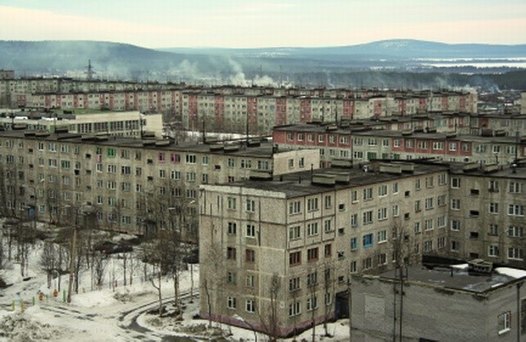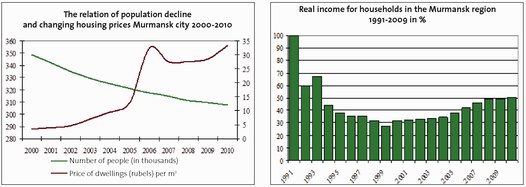
Typical Krutsjovky-style housing in Northwest Russia, here from Apatity. Note the different standards of windows. Photo: Odd Iglebaek
Until the 1960s most housing was built onsite - in the so-called Stalin style. In the decades thereafter the typical units were five storey high prefabricated concrete panel constructions. The flats were generally small with small rooms. All were provided with electricity, central heating, access to water and sewage systems. In architectural terms they are usually called "Krutsjovky". Many millions of such flats were built throughout the Soviet Union but also in neighbouring countries. Kabul, capital of Afghanistan, for example also has suburbs with such housing complexes built before the invasion in 1978.
Generally, housing-conditions in Northwest-Russia were better than in most other Soviet towns. In the 1980s, a new type of house, with more comfortable housing options, called the "advanced apartment" took over from the Krutsjovsky. They were higher, 9-16 storeys, and had more spacious flats.
All flats were rented and in principle nobody could own their own home. Heating was based on hot water district systems and was provided for eight months a year. The boilers were usually fired by oil. Temperature regulation was usually achieved through opening windows to let excess heat out. It is an expensive and wasteful system that produces more energy than is required.
In the early 1990s however the construction of new housing ground to a halt. Public money was simply not available. Gradually a private market was established in particular aimed at those who had grown richer in the preceding years. These privately built houses were also larger. While apartments built in the period 1990-1995 had an average area of 56m2, the floor-space for new flats built in the period 2008-2009 had, on average, increased to 120m2.
Since 2005, 152 villas generally between 200 and 250m2 and some even larger have been constructed. Most are located in the vicinity of the regional capital – Murmansk. In absolute terms these new private-owned single-dwellings, as well as townhouses, made up less than 3% of the total of Kola's housing-stock in 2010.
Thus some 97% of currently existing flats were constructed during the Soviet era. Most are now between 30 and 50 years old. The average apartment size is 50m2. 22% of these are one-room apartments, 50% have two-rooms, 26% three-rooms while only 2% have four-rooms or more.
For decades the Soviet-housing stock was badly maintained. Almost all of the available resources went into building more flats. In the Murmansk region the prevailing situation during the late 1990s was that some 60% of the housing stock suffered from severe deterioration. By 2008 an ongoing programme of improvements had reduced this figure to 25% measured against a 50% threshold. 13% had however suffered from physical deterioration calculated at more than 66%.
The level of spending for general repairs in respect of these apartment-blocks has remained stable for the last decade. In 2009 a partial general overhaul was undertaken for 192 blocks in the region, in 2010, another 156 were improved. The cost of this overhaul was more than 1 billion roubles. At this pace, by 2025, some 54% of the housing stock will suffer from a physical deterioration rate above 50%. In 1991 the Privatisation Law was passed. This introduced a legal market for property. People were given the right to buy and sell flats. According to this legislation, a house was divided into individual flats and common property areas such as the roof, stairs, lifts, etc. These common property areas belong to all apartment owners in the building.
Any decision about common property (for example, the use of the basement, painting walls, general overhaul etc.,) should be adopted by the owners' assembly. More than 50% of owners should participate in the assembly meeting to make decisions. In some cases, two-thirds of all owners must agree.
The land under and around a house is also considered to be a part of the 'common property.' The land area of a house depends on the size of the building, the number of floors, planning standards and the current surrounding situation. Also, in accordance with the Russian Land Code, the land is the property of apartment owners but few of these property owners pay a land tax. Previously, when land was a municipal property, tenants paid a small land-rent to the municipality.
After the new legislation was adopted the new owners received documentation only on their right to the flat. They did not receive documentation on land property or common property. The rights over the land upon which the property was built were not de jure specified. This situation has now however been rectified. All municipalities must now plan land for houses and register this land with the Land Committee. The Committee conducts a cadastral valuation of the land from which it will be possible to levy and collect a land tax.
In Murmansk region the volume of property transactions is constantly on the rise. A small recession in 2009 did not affect this general trend. 2010 in fact saw a total of no less than 11 000 dwelling transactions, some 25% more than in 2009.
The amount borrowed through the mortgage market has also grown considerably. In 2010 more than 2 000 houses were financed by such loans, equivalent to 18% of all transactions in the real estate market. For 2009 the figure was 1 200.
Since the early 1990s the price of housing has risen considerably except for 2009 when it fell by 8%. The first major rise in housing-prices came in 2002-2003. On average the increase was 90% for the period while the period 2005-2006 saw an increase of 120%!
Many centrally located flats have had their status changed to shops or offices. This only adds to rising prices for attractive properties.
The housing price dynamic in the region is in many respects defined by the real estate market in Murmansk city – the region's capital. About half of the regional population lives in Murmansk while almost half of the housing stock is situated in Murmansk.
The 120% rise during the period 2005-2006 was fuelled, primarily, by the optimistic expectations of both sellers and buyers. The potentials associated with the extraction of oil and gas from the Barents Sea shelf generated new optimism. Some companies began to open offices in Murmansk and to buy flats for their staff. When the development of the continental shelf became more uncertain housing prices fell by around 15%.
A population decline results in a theoretical increase in the housing supply. Many of the empty houses are however in areas characterised by depopulation, so nobody wants to buy them. They are simply left empty. Other areas are characterised by increased centralisation, like Murmansk city. Here there is rising demand particularly for larger and better quality housing.
Of course, sellers in general want to get as much as possible particularly as many of them are moving to the southern parts of Russia, where housing prices are higher than in Murmansk.
The income growth generated pushes many to invest in upgrading the quality of their properties – new kitchens, windows, bathrooms etc. This also adds to the value of the properties.
Thirdly, some places, again mostly in Murmansk city, have seen the introduction of a new rental market. Demand in this market is generated by people who come only to work and not to settle.
Fourthly and finally, banks and other lenders in the Murmansk region, as in the rest of the world, want prices to increase in order to bolster sales-volumes and profits while the growth of estate agents undoubtedly contributes to the rising cost of buying property.

By Lyudmila Zalkind, Senior Researcher, Institute for Economic Studies, Kola Science Centre, Russia